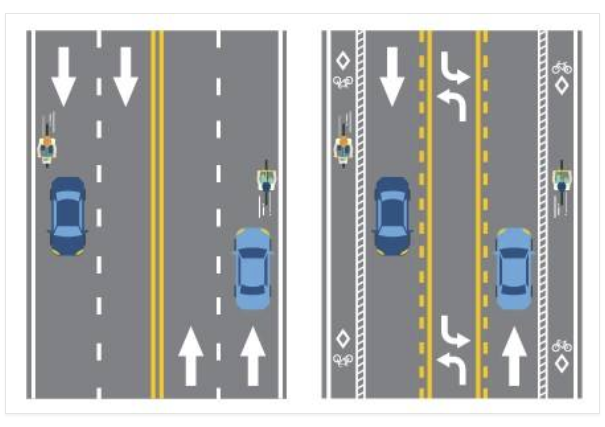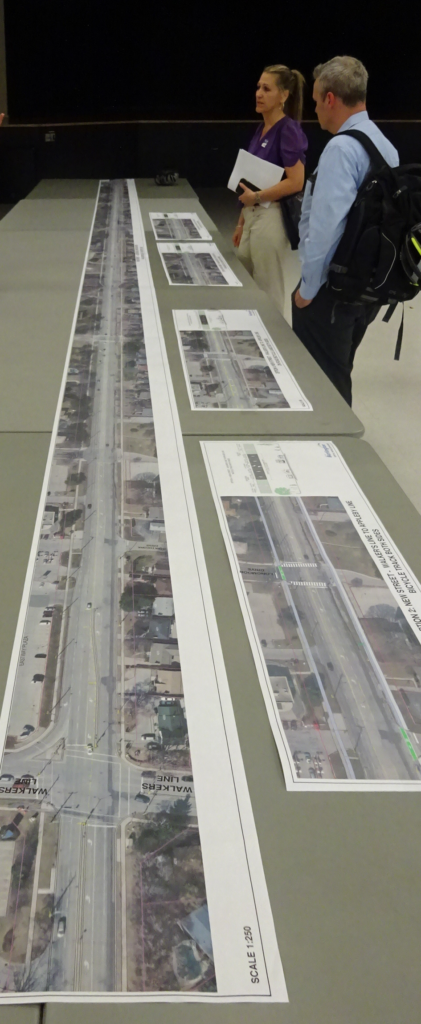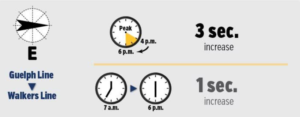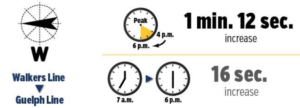 By Staff
By Staff
October 31st, 2017
BURLINGTON, ON

Before dedicated bike lanes on the lift – proposed lanes (and what is in place for the pilot) on the right.
Will city council actually make a final decision on the one-year pilot on a section of New Street between Walkers Line and Guelph Line, reducing the number of lanes from four to three with buffered bike lanes?
This issue has been mired in the Transportation department and the subject of much debate between the cyclists and car drivers.
A staff report with findings from the one-year New Street pilot project will be presented to Burlington City Council at the Committee of the Whole meeting on Mon. Nov. 27 at 6:30 p.m. A copy of the report will be available beginning Nov. 18 and can be found on the city’s webpage dedicated to the project.
Throughout the one-year New Street pilot project, the city will be sharing updates and information collected.
Comparison of travel times on New Street before and after the implementation of the one-year pilot:

All kinds of graphics material was made available to the public – problem was the public didn’t show up at the public meetings. Less than 20 people – more staff than tax payers.
A Closer Look at the Numbers:
Travel time data on New Street between Walkers Line and Guelph Line was captured using BlueMAC technology. When an outbound bluetooth signal is detected from a passing mobile phone or car, the BlueMAC technology, located at New Street and Walkers Line and New Street and Guelph Line, is able to record the travel time of each vehicle.
While the number of recordings does not represent the total number of cars using New Street during the times above, it does provide a sample size that is significantly larger than one captured manually.
Ward 2 city Councillor sets out her position in her newsletter: “Residents have reported significant delays turning from side streets onto New St, increased traffic on side streets that weren’t intended to handle the volume, and delays in travelling at certain times of the day.
“More than 2000 people have signed a petition seeking an end to the pilot project. We need to consider the lived experience and input from residents as much as the Bluetooth data. We have yet to learn whether there has been an increase in cyclists due to the new lanes, but we know the lanes have impacted thousands of drivers.
“When there is an accident on the QEW or 403, there is no extra capacity to take the volume on our streets, including New, leading to significant gridlock. When people are commuting home from long work days, or meetings or errands, each extra minute in traffic is precious time away from family. Based on what I have heard and learned so far, it doesn’t make sense to continue the lane restriction.”

Our experience was a little more than the time shown on this graphic.

This is about what the Gazette experienced.
The Gazette’s experience on travelling the route: We experienced minimal delay – what we didn’t see was any more than two cyclist on the route at any one time – and most of the time there were none. On two occasions we did see cyclists using the sidewalk.
This has been one of the more divisive issues Burlington has had to contend with for some time.
Biggest question is – How much has the city spent on this project in terms of staff time?















We have a City that wants to attract people to live downtown and for us all to use bikes. Sounds great, but we have the same roads that were here 60 years ago, road diets on New Street and Lakeshore, a very small group of rarely seen cyclists that have the ear of City Hall and a dated public transit system that doesn’t reflect the needs of today’s ridership.
I just returned from a vacation in Northern Italy and drove from Venice to Castelfranco TV, not a single bike lane, or sharrow in sight, but lots of cyclists of all ages and motorists and pedestrians getting along. I cycle west to east on centennial and a bit on New St, can’t see the logic or statistics that support the continuation of the experiment.
An interesting observation, Joe. When I visit the Yorkshire Dales and the Lake District (Cumbria) in England, I also encounter many cyclists but they are exceptionally courteous to the motoring public and that is reciprocated. None of the “attitude” that I experience here in Burlington/Halton. Not sure what the problem is.
I am sorry but city hall does not listen, I have lived in Burlington for over 40 years and have seen the idiotic reduction of roads in all directions.
No one listens, Burlington is the QEW by-pass and now with all these changes it is gridlock out there.
Anyone can see what happens when the QEW closes down, but city hall doesn’t seem to care.
Bike paths belong on the sidewalk area not on the road, some cyclists are plain ignorant, and do not follow the rules of the road.
Stop this and return the roads to the automobiles
I live on a court just west of Walkers Line off of New St. Inevitably, when there is gridlock in the westbound lane (which occurs often at the end of the day), drivers turn up our street, thinking it will get them to Rexway or Walkers Line. They overlook the No Exit sign. When they reach the court (which is not visible upon approaching it), they circle around and then speed back to New St. The speed limit is 40 km/hr, but in their haste and frustration, they ignore that too. There are no sidewalks on our street. Children play, people walk their dogs up to the bikeway. One day, someone is going to get hurt. I’ve lived here for nine years and have only seen this driver behaviour since the road diet was introduced. I doubt that the report will include any of this, but the city has to know, and will. This is supposed to be a safe, quiet street. It is not anymore.
That’s a really good observation CMG. A few dozen bikes will be safer but the traffic diverting off New Street makes the side streets more dangerous. Wonderful.
And what is truly shocking is that the City knew that this would be a consequence.
Notice all the “speed bumps” put on these side streets as a result of the New Street Fiasco. Of course, despite a rumoured cost of $4000 each,they don’t work but they do act like Linus’ blanket.
The road diet is not only an example of a wasted initiative but a sad commentary on what happens when municipal politicians and the minions at City Hall don’t listen. It has been a costly waste of time and money.
I just drove from downtown Burlington to my home along New Street at 4:00 p.m. Not a single cyclist on either side of the road. If you are driving and get behind a school bus, a City bus or a slow moving truck travelling time is extended. When there is an accident on the Skyway or QEW traffic offloads onto Fairview and New Streets thereby increasing congestion. Many people I have spoken to now totally avoid New Street altogether.
The City should have taken the $216K they wasted on this and spent it on upgrading local transit or improving sidewalks. Either initiative would have been a better use of taxpayers’ money.
I notice no mention of the daily bicycle traffic, in numbers. Why? You know, so we can see how badly the tail is wagging the dog.
Sadly, I have no doubt that the report will show the pilot has been a success, and will be in favour of actually expanding the “road diet” to all of New Street. Data can always be manipulated to match the desired outcome.
I think another writer has described this as “policy-based evidence making” in relation to other activities at City Hall. I prefer the term that Harry Truman popularized, “There are 3 kinds of lies–lies, damn lies, and statistics”.
I didn’t notice much of a difference in traffic delays during the rush hours than I experienced when I lived in that area 3 years ago. Actually, it seemed to have improved considerably in my experience. At least during the 4-6pm rush hour.
However having said that I did perceive an increase in traffic on Lakeshore Rd. during the rush hours. Especially the 4-6 rush. Westbound Lakeshore Rd. was already quite congested before the New Street Road Diet but in my opinion it has worsened considerably. I supposed enough so that the city decided to install a new set of traffic lights in proximity to the Lakeshore Rd public school for the childrens’ safety.